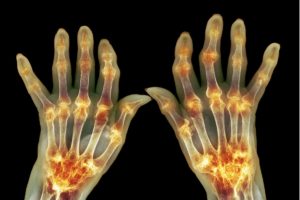 About half of all women and one-quarter of all men will experience the stiffness and pain of osteoarthritis (OA) of the hands by the time they are 85 years old. Also known as “wear and tear” arthritis, OA causes the smooth, protective cartilage on the ends of your bones to break down and wear away. Over time bones rub together, causing pain. The 29 bones of your hands and wrists come together to form many small joints that can be affected by OA. When osteoarthritis affects your hands, everyday activities such as opening jars and using a cell phone can be difficult. The following shares a few ways to help manage the pain…
About half of all women and one-quarter of all men will experience the stiffness and pain of osteoarthritis (OA) of the hands by the time they are 85 years old. Also known as “wear and tear” arthritis, OA causes the smooth, protective cartilage on the ends of your bones to break down and wear away. Over time bones rub together, causing pain. The 29 bones of your hands and wrists come together to form many small joints that can be affected by OA. When osteoarthritis affects your hands, everyday activities such as opening jars and using a cell phone can be difficult. The following shares a few ways to help manage the pain…
Exercise Your Hands
To maintain flexibility, strength, and range of motion, consider the following exercises…
- Make a gentle fist, wrapping your thumb across your fingers. Hold for 30 to 60 seconds. Release and spread your fingers wide. Repeat with both hands at least four times.
- Hold your hand in an open natural position. then move your thumb to the base of the pinky finger. repeat this movement several times on each hand.
- Place your hand palm-down on a table or other flat surface. Gently straighten your fingers as flat as you can against the surface without forcing your joints. Hold for 30 to 60 seconds and then release. Repeat at least four times with each hand.
- Hold your hand in the air. Keep the fingers upright and close together. Next, make a “c” shape using your fingers and thumb. gently come out of the position and repeat. Perform this exercise with both hands.
- Place your hand palm-down on a table or other flat surface. Gently straighten your fingers as flat as you can against the surface without forcing your joints. Hold for 30 to 60 seconds and then release. Repeat at least four times with each hand.
Finding the right balance between activity and rest is the way to keep the osteoarthritic joint healthy.
Apply Heat or Cold
For moderate to severe pain from osteoarthritis, try applying heat and cold to the affected joints. Experiment with these heat and cold techniques until you find what helps you most.
- Try putting cold packs on a painful joint for 10 to 20 minutes. Do not apply a cold pack directly to bare skin. Put a thin towel or pillowcase between the ice and your skin
- Use Ice massage. Rub an ice cube in small circles all over the affected area. Put a moisture barrier such as a section of plastic bag over the area, so the ice is not directly touching the skin. To try this, hold the plastic in place with one hand and rub the ice over it with the other hand. You can do an ice massage several times a day if it helps you.
- Applying heat can help calm hand pain and stiffness by relaxing soft tissues, increasing circulation, and stimulating the production of joint fluid. Use an electric heating pad, warm water bottle, paraffin wax bath, or heat wrap.
Make Some Wardrobe Changes
You can help the strain and overall pain and stiffness of osteoarthritis by making some minor changes to your wardrobe…
- Look for clothing styles with larger zippers or oversized buttons — they might not be as hard to manage as regular-sized fasteners.
- Try shoes that slip on or use Velcro rather than shoelaces
- If you like to wear jewelry check with your local jewelry store to see if they can attach magnetic clasps so that you can enjoy them once again.
- Purchase slacks that have an elastic waistband rather than snap and zippers.
Consider Topical Pain Medication
Medications can help by easing pain and inflammation. Over the counter gels, creams or patches are ideal for hand joints. Regardless of how they are applied, most topical arthritis pain relievers fall into these categories…
- Capsaicin (Capzasin, Zostrix, Icy Hot). Derived from cayenne peppers, this OTC drug comes as an ointment.
- Diclofenac sodium gel and solution (Voltaren, Flector Patch, Solaraze, Pennsaid). …
- Lidocaine patch. …
- Methyl salicylate and menthol (Bengay). …
- Trolamine (Aspercreme).
- Cannabidiol (CBD) products
It is always advisable to talk to your doctor before trying any new medication. Be careful because the ingredients can enter the bloodstream and produce side effects with other medications.
Try an Anti-Inflammatory Diet
Researchers have identified certain foods that can help control inflammation. Many of them are found in the so-called Mediterranean diet, which emphasizes fish, vegetables, and olive oil, among other staples. Foods that contribute to inflammation such as processed, fried and sugary foods should be avoided. Track your symptoms and learn what treatment works best for you. Thinking ahead and making adjustments can make your life with hand pain from osteoarthritis a little easier.
For persistent joint pain that is interfering with your daily activities, see a Tristate rheumatologist to make the correct diagnosis and begin the proper treatment.
Contact Us (859-331-3100) For More Information to Request an Appointment
—
 About Tristate Arthritis and Rheumatology
About Tristate Arthritis and Rheumatology
Tristate Arthritis and Rheumatology is first and largest Rheumatology practice in the Northern Kentucky area. Founded by Dr. Arthur Kunath in 1986, our rheumatology practice now consists of six doctors who are board certified in both Internal Medicine and Rheumatology and a Physician Assistant. Patients see one doctor (except in emergencies), thereby assuring continuity of care and an individualized doctor-patient atmosphere giving the physician the ability to establish personalized and detailed relationships. Our doctors have received numerous awards, including being listed as “Top Doctors” in Cincinnati Magazine, receiving the Patient’s Choice Award, the Most Compassionate Doctor Award, and the American College of Rheumatology’s “My Doc Rocks” award.
>> Learn More


